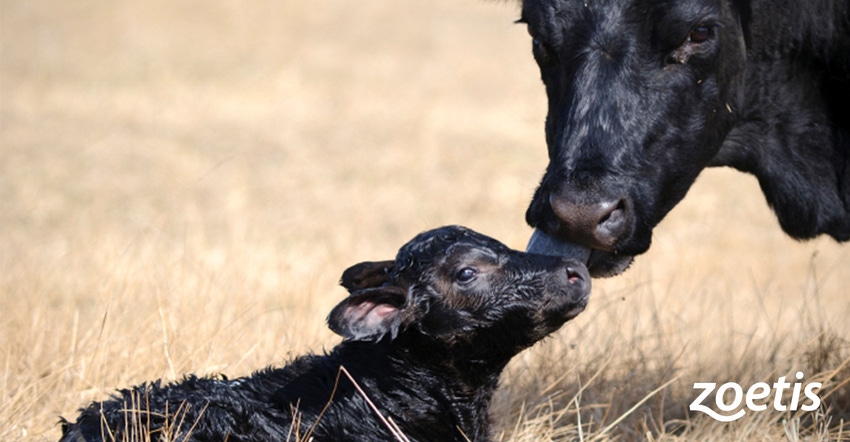Cow/calf producers can save nearly twice as much by preventing respiratory disease instead of treating disease in young calves.
October 7, 2019

Sponsored Content
Protecting calves from respiratory disease can be a positive for animal well-being and the bottom line. Calving season is underway in fall calving areas and getting those calves off to a healthy start is top of mind for cattle producers.
Preventing respiratory disease is not only best for overall animal health and productivity, but recent studies demonstrate there can be an economic benefit for a cow/calf operation.
Journal of the American Veterinary Medical Association (JAVMA) recently published a study based on a survey of cow/calf producers n=43 in multiple states. The study evaluated and compared the estimated current costs of vaccines and vaccine administration to calves for disease protection with the medication and labor costs of treating a calf with respiratory disease.1
The JAVMA study reveals that the cost per calf to treat respiratory disease is more than twice the cost of preventing respiratory disease. Median vaccine cost per calf in the surveyed herds was $6.25, while labor costs were $5 for administering vaccine to calves. Medicine cost to treat a sick calf averaged $11, while treatment labor costs were $15 per calf.1
A proven approach to the young calf’s immune system
A young calf’s immune system is unique in how it responds to viral and bacterial challenges. Calfhood vaccinations can complement what the dam provides through colostrum and help give a calf every chance to be healthy and perform to its potential. Timing and type of vaccine administration play key roles in managing the young calf’s immune response.
Challenge studies demonstrated that the intranasal vaccine works with the calf’s immune system to prevent respiratory disease caused by bovine respiratory syncytial virus (BRSV) and helps prevent respiratory disease caused by infectious bovine rhinotracheitis (IBR).2,3
“Research out of North Dakota demonstrated that vaccination at birth can improve future responses to vaccination, while helping provide protection against respiratory diseases from birth to weaning,”4 said Victor Cortese, DVM, PhD, director of immunology and biologicals with Zoetis.
A field study, not a USDA challenge study, in Montana helps support the Zoetis recommendation to use Inforce 3® at birth followed by a second dose of Inforce 3 and One Shot® BVD to protect against BRSV, IBR, PI3, bovine viral diarrhea (BVD) Types 1 and 2 and Mannheimia haemolytica, before heading to pasture.5
Cortese concluded with three things a cow/calf producer will see from implementing young calf respiratory vaccinations:6,7
Lower pneumonia rates
Lower death loss
Greater weight gains.
To develop a vaccination protocol for your young nursing calves, consult with your local veterinarian, or visit CompleteCalfProtection.com to learn more about solutions from Zoetis.
1Wang M, Schneider LG, Hubbard KJ, et al. Beef producer survey of the cost to prevent and treat bovine respiratory disease in preweaned calves. J Am Vet Med Assoc. 2018;253(5):617-623.
2 Mahan SM, Sobecki B, Johnson J, et al. Efficacy of intranasal vaccination with a multivalent vaccine containing temperature-sensitive modified-live bovine herpesvirus type 1 for protection of seronegative and seropositive calves against respiratory disease. J Am Vet Med Assoc. 2016;248(11):1280-1286.
3 Ellis JA, Gow SP, Mahan S, Leyh R. Duration of immunity to experimental infection with bovine respiratory syncytial virus following intranasal vaccination of young passively immune calves. J Am Vet Med Assoc. 2013;243(11):1602-1608.
4 Stokka GL, Neville B, Seeger JT, Stoltenow C, Dyer N, Gaspers JJ. Evaluation of the serologic effect of concurrent IBR, BRSV, PI3 and Mannheimia vaccination and time interval between the first and second dose on the subsequent serological response to the Mannheimia toxoid and BRSV fractions on spring-born beef calves in North Dakota. North Dakota Beef Report 2014;40-42.
5 Data on file, Study Report No. 16CARGBIO01, Zoetis Inc.
6 Perino LJ, Hunsaker BD. A review of bovine respiratory disease field efficacy. Bov Pract. 1997;31:59-66.
7 Mosier DA, Confer AW, Panciera RJ. The evolution of vaccines for bovine pneumonic pasteurellosis. Res Vet Sci. 1989;47:1-10.
All trademarks are the property of Zoetis Services LLC or a related company or a licensor unless otherwise noted. © 2019 Zoetis Services LLC. All rights reserved. INF-00094
About the Author(s)
You May Also Like



